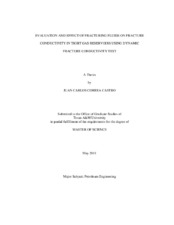| dc.description.abstract | Unconventional gas has become an important resource to help meet our future
energy demands. Although plentiful, it is difficult to produce this resource, when locked
in a massive sedimentary formation. Among all unconventional gas resources, tight gas
sands represent a big fraction and are often characterized by very low porosity and
permeability associated with their producing formations, resulting in extremely low
production rate. The low flow properties and the recovery factors of these sands make
necessary continuous efforts to reduce costs and improve efficiency in all aspects of
drilling, completion and production techniques. Many of the recent improvements have
been in well completions and hydraulic fracturing. Thus, the main goal of a hydraulic
fracture is to create a long, highly conductive fracture to facilitate the gas flow from the
reservoir to the wellbore to obtain commercial production rates. Fracture conductivity
depends on several factors, such as like the damage created by the gel during the
treatment and the gel clean-up after the treatment.
This research is focused on predicting more accurately the fracture conductivity,
the gel damage created in fractures, and the fracture cleanup after a hydraulic fracture treatment under certain pressure and temperature conditions. Parameters that alter
fracture conductivity, such as polymer concentration, breaker concentration and gas flow
rate, are also examined in this study. A series of experiments, using a procedure of
“dynamical fracture conductivity test”, were carried out. This procedure simulates the
proppant/frac fluid slurries flow into the fractures in a low-permeability rock, as it
occurs in the field, using different combinations of polymer and breaker concentrations
under reservoirs conditions.
The result of this study provides the basis to optimize the fracturing fluids and
the polymer loading at different reservoir conditions, which may result in a clean and
conductive fracture. Success in improving this process will help to decrease capital
expenditures and increase the production in unconventional tight gas reservoirs. | en |


